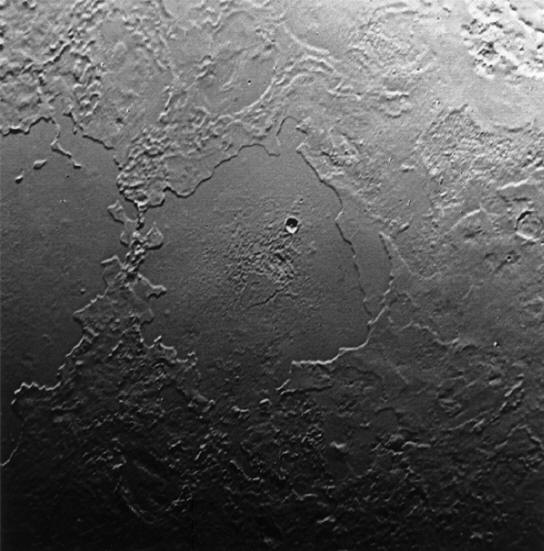|

The surface of Neptune's
moon Triton. Credit: NASA/JPL.
Voyager 2 mission.
Neptune's Herald
Oct
04, 2010
Summer has finally come to
Triton.
Neptune's largest moon
accompanies the giant gas planet as
it travels in an elliptical orbit
around the Sun at an average
distance of about 4,495,060,000
kilometers. Neptune requires
approximately 165 Earth years to
complete one revolution, so summer
arrives at infrequent intervals on
its near planet-sized moon.
On August 25, 1989, Voyager 2
became the first spacecraft to
return close-up images of Neptune
and its moons. Neptune is now
officially recognized as the most
distant planet from the Sun, since
Pluto was voted to be a Kuiper Belt
Object. It was during Voyager's
flyby that six of Neptune's thirteen
known moons were discovered.
Triton is in a retrograde orbit
around Neptune, circling the planet
opposite to the direction of its
rotation, and is the only moon in
the Solar System to exhibit that
configuration. Most of its other
moons are not visible from Earth,
and little is known about them.
About half are so close to Neptune
that Earth-based telescopes are not
able to resolve them against its
background.
Triton is one of the Solar
System's strangest moons. First, it
has an atmosphere, cold and thin as
it is. However, it shares that
characteristic with only two others:
Jupiter's moon Io, and Saturn's moon
Titan. Triton's atmospheric pressure
is greater than Io's but less than
Titan's: only 1/100,000 that of
Earth.
Second, its anomalous retrograde
orbit could indicate that Triton is
a captured body, but one that is
unusually big. Triton is two-thirds
the size of Earth's Moon. Third, its
temperature makes it the coldest
place known in the Solar System at
-235 Celsius, yet so-called
"nitrogen geysers" were seen spewing
out of cracks in its surface. It is
thought that those gas eruptions are
what give Triton its atmosphere.
The geyser-like formations
shooting nitrogen gas and dust
particles eight kilometers into
space were one of the Voyager
mission's greatest surprises. They
were called “ice
volcanoes,” and
several were identified
in the south polar region.
Triton's surface features
resemble those on Ariel, one of the
moons circling Uranus; or those seen
on Enceladus, one of Saturn's moons;
as well as Jupiter's moons Europa,
Ganymede, and Io. There are also
polar ice caps similar to those on
Mars, although Triton appears to
most resemble Pluto in temperature,
size, and chemical composition.
According to a recent
press release, the
European Southern Observatory (ESO)
has used their Very large Telescope
to perform an infrared analysis of
Triton's atmosphere. Since Triton
changes seasons once every forty
years, this is the first time in
over a century that summertime
observations have even been
possible.
The southern summer solstice
began in 2000, and scientists think
that the atmosphere has become much
thicker since then due to the
sublimation of ices off the moon's
surface. Not just nitrogen, but
carbon monoxide and methane have
been detected in an upper layers of
ice. They believe it is vapors from
those thin layers, evaporated by the
remote Sun, that have thickened the
atmosphere.
The geysers, darkened cavities,
and "wind streaks" on Triton have
been explained as electric discharge
effects in other locations. A
previous
Thunderbolts Picture of the Day
noted an association with the
bizarre “Dalmatian spots” and
geysers on Mars. The apparent role
of charged particle beams excavating
ice, and provoking massive geyser
activity was offered as a possible
explanation:
“If the dark spotting on Mars’
south polar ice is indeed caused by
charged particle streams, one of the
first things we should look for is
an active response of the surface to
these events. Since the dark
spotting is occurring in the Martian
south polar spring, that would be
the time to look for signs of
energetic activity, not unlike the
so-called 'volcanic' plumes of
Jupiter’s closest moon Io, or the
'geysers' of Saturn’s moon Enceladus.”
Consensus scientists typically
ignore electricity when observing
events in Neptune’s frigid vicinity.
They do not consider that similar
formations on Io, Enceladus, or Mars
are even relevant to the geological
condition of Triton. They do not
realize that those differences are
not an issue when an electrical
interpretation is considered.
Instead of the Sun's heat
influencing the change of seasons on
Triton, perhaps the orientation of
the moon within the electric fields
generated by its parent body should
be considered.
Stephen Smith
|







